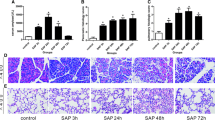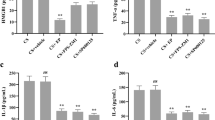Abstract
Aim
We tested our hypothesis that Myc-interacting zinc finger protein 1 (MIZ1), a cell cycle regulator, suppressed inflammation, and therefore, represented a useful prognostic marker in patients with acute necrotizing pancreatitis (ANP) complicated by acute lung injury.
Methods
Sprague–Dawley rats were randomly divided into control and ANP groups at different time points. The MIZ1 protein expression was measured by Western blot and ELISA, and confirmed using immunohistochemistry. The severity of pancreatic and lung injury was evaluated by the injury score and wet/dry weight ratio. The severity of disease was evaluated by serum C-reactive protein (CRP). The MPO activity of lung tissue amylase levels and the degree of inflammation were evaluated by serum tumor necrosis factor (TNF)-α and interleukin (IL)-6 expression. The risk due to multiple factors was investigated by relationship analysis.
Results
The serum levels of CRP, amylase, TNF-α, and IL-6 were gradually increased at 6, 24, and 48 h in ANP when compared with the control rats. The MIZ1 expressions were greatly decreased in ANP rats, especially at 24 h. Statistical analysis showed that there were time-dependent differences in ANP rats when compared with control rats (6 vs. 24 or 48 h, P < 0.01). MIZ1 showed close negative correlation with the degree of pancreatic and lung injury, serum amylase, CRP, TNF-α, and IL-6 (P < 0.01, respectively).
Conclusion
The decreasing MIZ1 expression was closely correlated with inflammatory response, and development of ANP. Decreasing MIZ1 levels indicate a risk for ANP.






Similar content being viewed by others
References
Li J, Yang WJ, Huang LM, Tang CW. Immunomodulatory therapies for acute pancreatitis. World J Gastroenterol. 2014;20:16935–16947.
Banks PA, Bollen TL, Dervenis C, et al. Classification of acute pancreatitis-2012: revision of the Atlanta classification and definitions by international consensus. Gut. 2013;62:102–111.
Schneider L, Jabrailova B, Strobel O, Hackert T, Werner J. Inflammatory profiling of early experimental necrotizing pancreatitis. Life Sci. 2015;126:76–80.
Stead MA, Wright SC. Structures of heterodimeric POZ domains of Miz1/BCL6 and Miz1/NAC1. Acta Crystallogr F Struct Biol Commun. 2014;70:1591–1596.
Vousden KH. Switching from life to death: the Miz-ing link between Myc and p53. Cancer Cell. 2002;2:351–352.
Patel JH, McMahon SB. BCL2 is a downstream effector of MIZ-1 essential for blocking c-MYC-induced apoptosis. J Biol Chem. 2007;282:5–13.
Miao L, Song Z, Jin L, et al. ARF antagonizes the ability of Miz-1 to inhibit p53-mediated transactivation. Oncogene. 2010;29:711–722.
Lin A. Temporal control of TNFα signaling by Miz1. Adv Exp Med Biol. 2011;691:127–128.
Ping C, Yongping Z, Minmin Q, Weiyan Y, Yaozong Y. Activated protein C improves the severity of severe acute pancreatitis via up-regulating the expressions of endothelial cell protein C receptor and thrombomodulin. Dig Dis Sci. 2010;55:1599–1609.
Tanaka A, Minoguchi K, Chen X, et al. Activated protein C attenuates leukocyte elastase-induced lung injury in mice. Shock. 2008;30:153–158.
Zerem E. Treatment of severe acute pancreatitis and its complications. World J Gastroenterol. 2014;20:13879–13892.
Sah RP, Dawra RK, Saluja AK. New insights into the pathogenesis of pancreatitis. Curr Opin Gastroenterol. 2013;29:523–530.
Wang J, Xu P, Hou YQ, Xu K, Li QH, Huang L. Pancreatitis-associated ascitic fluid induces proinflammatory cytokine expression in THP-1 cells by inhibiting anti-inflammatory signaling. Pancreas. 2013;42:855–860.
Malleo G, Mazzon E, Siriwardena AK, Cuzzocrea S. TNF-alpha as a therapeutic target in acute pancreatitis lessons from experimental models. Sci World J. 2007;7:431–448.
Staubli SM, Oertli D, Nebiker CA. Laboratory markers predicting severity of acute pancreatitis. Crit Rev Clin Lab Sci. 2015;16:1–11.
Dambrauskas Z, Gulbinas A, Pundzius J, Barauskas G. Value of the different prognostic systems and biological markers for predicting severity and progression of acute pancreatitis. Scand J Gastroenterol. 2010;45:959–970.
Sendler M, Dummer A, Weiss FU, et al. Tumour necrosis factor α secretion induces protease activation and acinar cell necrosis in acute experimental pancreatitis in mice. Gut. 2013;62:430–439.
Siemiatkowski A, Wereszczynska-Siemiatkowska U, Mroczko B, Galar M, Maziewski T. Circulating endothelial mediators in human pancreatitis-associated lung injury. Eur J Gastroenterol Hepatol. 2015;27:728–734.
Saito M, Novak U, Piovan E, et al. BCL6 suppression of BCL2 via Miz1 and its disruption in diffuse large B cell lymphoma. Proc Natl Acad Sci USA. 2009;106:11294–11299.
Inoue S, Hao Z, Elia AJ, et al. Mule/Huwe1/Arf-BP1 suppresses Ras-driven tumorigenesis by preventing c-Myc/Miz1-mediated down-regulation of p21 and p15. Genes Dev. 2013;27:1101–1104.
Kosan C, Saba I, Godmann M, et al. Transcription factor miz-1 is required to regulate interleukin-7 receptor signaling at early commitment stages of B cell differentiation. Immunity. 2010;33:917–928.
Liu J, Yan J, Jiang S, et al. Site-specific ubiquitination is required for relieving the transcription factor Miz1-mediated suppression on TNF-α-induced JNK activation and inflammation. Proc Natl Acad Sci USA. 2012;109:191–196.
Yang Y, Do H, Tian X, et al. E3 ubiquitin ligase Mule ubiquitinates Miz1 and is required for TNF alpha-induced JNK activation. Proc Natl Acad Sci USA. 2010;107:13444–13449.
Liu J, Zhao Y, Eilers M, Lin A. Miz1 is a signal- and pathway-specific modulator or regulator (SMOR) that suppresses TNF-alpha-induced JNK1 activation. Proc Natl Acad Sci USA. 2009;106:18279–18284.
Do-Umehara HC, Chen C, Urich D, et al. Suppression of inflammation and acute lung injury by Miz1 via repression of C/EBP-δ. Nat Immunol. 2013;14:461–469.
Acknowledgments
This work was supported by the National Natural Science Foundation of China (No. 81170437).
Author information
Authors and Affiliations
Corresponding author
Ethics declarations
Conflict of interest
The authors declare that they have no conflict of interest.
Rights and permissions
About this article
Cite this article
Chen, P., Wang, W., Zhang, Y. et al. Decreased MIZ1 Expression in Severe Experimental Acute Pancreatitis: A Rat Study. Dig Dis Sci 61, 758–766 (2016). https://doi.org/10.1007/s10620-015-3951-y
Received:
Accepted:
Published:
Issue Date:
DOI: https://doi.org/10.1007/s10620-015-3951-y




